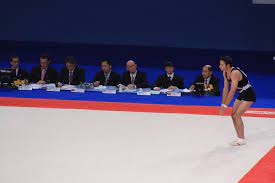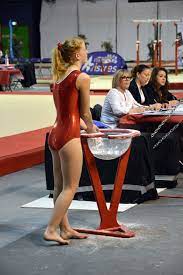
Olympic judges have a critical role. Their scoring decisions can impact an athlete’s career and dreams at the highest levels of competition. But how does one become suitably qualified and then selected to take on the pressure of judging an Olympic routine?
Like gymnasts, judges dedicate hours to training, education, and experience before reaching the official’s table.”
Let’s take an in-depth look at how to become an Olympic judge and overview the typical judges career journey and advancement.
Olympic Judge Qualifications and Requirements
While the road is long, the baseline qualifications to become a new gymnastics judge are straightforward. National bodies like USA Gymnastics, British Gymnastics, and FIG set the core criteria for judges. While specific requirements vary slightly, judges universally need to meet the following:
Minimum Age of 18 – All major gymnastics organisations require judges to be at least 18 years old before starting formal training. Some allow students to begin classroom learning at 16, but prohibit officiating until reaching adulthood. USA Gymnastics mandates judges be a minimum of 18 before starting any judging education.
Gymnastics Experience – Some governing organizations mandate that prospective judges have prior firsthand experience as a gymnast, coach, or other active participation in the sport. For example, USA Gymnastics requires previous competitive experience at the compulsory or optional levels, or coaching expertise at designated levels before beginning judge training. This ensures new judges have an innate basic grasp of gymnastics skills and physiology.
In the UK, British Gymnastics does not require previous experience, allowing more people to start judging. A significant number of judges have come into the sport firstly as a parent before volunteering to support.
The lower barrier to entry in the UK is needed as many clubs and competitions struggle to find enough qualified judges.
Rules and Regulations Knowledge – Extensive familiarity with the sport’s technical rules is a prerequisite. At Olympic level, judges must thoroughly master the FIG Code of Points, which governs skill values and scoring specifications, along with all other guidelines that regulate gymnastics. Intensive testing on regulations is part of judge training. At lower level meets there will be a set of specific rules that are usually simpler than the full FIG Cop but still need to familiarised.

Professionalism – Integrity, impartiality, discretion, and professional conduct are mandatory. Judges must leave any personal biases or agendas aside. Diplomatic communication skills are also vital to confer with the judging panel and offer gymnasts constructive feedback.
Time Commitment – Aspiring judges should ensure they have adequate time to dedicate to the training process, which can take months or even years. Once certified, an ongoing commitment to judging assignments, continuing education, and travel is required. To be selected as an Olympic judge, prospective candidates will have already judged at major international competitions around the world. This takes up a significant amount of travel time and commitment away from other employment, friends and family but its essential to build up enough high level experience to be considered for a Olympic role.
Motivation – Successful judges have a genuine passion for the sport and desire to be close to the action helping shape the next generation of gymnastics stars. Monetary compensation is low especially at the start so the role is a labor of love.
Olympic Gymnastics Judge Education
The core of becoming an Olympic judge is completing gymnastics-specific training courses and education programs. The curriculum are designed by judging commissions within national governing federations or regional sports authorities. While slightly varied, the core education components are similar worldwide.
Classroom Knowledge – Judges spend significant time in classrooms, learning rules, the Code of Points, and scoring methods in detail. Memorising point values for skills, understanding which deductions to take for errors, and learning proper terminology are key areas of knowledge.
Practical Experience – No classroom theory can replace hands-on experience. Trainees practice scoring routines and writing deductions under the guidance of senior judges at local competitions and clubs. They learn critical skills like maintaining split-second concentration, ignoring distractions, and separating emotions from duty. Potential Olympic judges are expected to progress through local, regional, national and then international events.
Examinations – Written and practical skills exams at intervals ensure judges meet strict technical standards on rules, deductions, and scoring as they progress through training levels. Exams get progressively more difficult.
Shadowing – Before fully certifying, judges shadow high-level competitions to witness firsthand how veteran judges operate under pressure at major events and absorb their wisdom.
Many federations break the training into multiple phases leading to different rankings such as State or Regional certification before National or International levels. Specific apparatus (vault, bars, etc.) are also certified individually as the judge gains proficiency. The entire process usually takes 1-2 years depending on involvement level. Dedicated trainees can accelerate the journey by immersing themselves fully in opportunities.
Career Progression for Olympic Judges
Education continues for judges aiming to reach the highest level. For those who excel, a clear career path emerges.
Local/State Meets – Newly certified judges typically begin building competence at local club competitions and lower-level regional meets. Here they gain confidence in their skills with less pressure.
Sectional/Regional Events – With experience, judges officiate at higher-profile events like Sectional qualifiers, Regional Championships, and national events.
National Certification – Extensive experience and excellent ratings at the lower levels may allow a judge to apply for and earn a National certification. This qualifies them to judge top National meets like U.S. Championships for one or more apparatuses.
International Eligibility – Seasoned National judges with many years of error-free experience may earn the elite FIG Brevet rating, qualifying them to judge international events including World Cups and World Championships.
Olympics – The absolute pinnacle is to be selected by FIG to judge at the Olympic Games. This is a rarely achieved honor reserved only for the most esteemed judges with pristine reputations.
Reaching the top tier and major international events takes most of a lifetime. Gymnastics authorities carefully track judges’ experience levels, technical skills, consistency, integrity, fitness, and conduct throughout their careers. Those achieving the highest rankings often later transition into leadership roles like Meet Referee or Technical Director to guide the next generation.
While demanding, dedicated judges find the long path incredibly rewarding. Officiating provides a way to stay closely involved in a beloved sport and meaningfully impact young athletes’ journeys.
How are Olympic Judges Selected?
The Olympics take place every four years, and each sport nominates judges to the International Olympic Committee (IOC). The FIG selects gymnastics judges from national federation nominations, ensuring a balanced quota from around the world.
USAG will nominate judges for the USA, British Gymnastics will nominate for Great Britain. The FIG can choose to accept or decline those nominations before submitting a final delegation to the IOC.
Men’s Artistic, Women’s Artistic, Rhythmic and Trampolining make up the Olympic gymnastics program and within each discipline there are different types of judges with specific roles.
- Difficulty Judges who calculate the value of each individual skill performed
- Execution Judges who mark the routine out 10
- CJP (Chair of the Judging Panel) who oversees the other judges
- Judge for Horizontal Displacement and Time of Flight (Trampoline only)
- Judge for Syncronisation (Syncro Trampoline only)
To be selected for the Olympics, judges must be top representatives with the required experience and qualifications. These types of decisions are often made by committees and its fair to say internal politics may play a part.
Other Reasons to Become a Gymnastics Judge
Not every prospective judge harbors an ambition to be a part of the Olympics.
Meet organizers often require clubs to provide a judge, ensuring enough officials for the event Therefore coaches, ex-gymnasts and parents often begin their judging pathway in order to help support regional level events to take place.
It also means that clubs avoid a fine from the organizer for fulfilling their judging quota.
How Much Do Judges Make
Depending on the event, a gymnastics judge can make $300 – $400 per day (USA Gymnastics).
However, they don’t receive a regular salary as events typically run during certain times of the year and mostly on the weekends. Judges are compensated per day or per session in the US therefore it is often an additional income to a second job or a coaching role.
Other countries will have different systems in place. In the UK, most gymnastics judges earn less than in the USA. Many volunteer or receive only travel and accommodation expenses.
A handful of people working at the International level or at the FIG will be employed in a full-time role to oversee the highest regulations within the sport. At this level, one would expect to be well paid as the positions carry a huge responsibility. However, these types of roles are small in number and there are not enough regular high-level events to make employing actual judges sustainable.
Maintaining Judge Certification and Licenses
Judging qualifications are not lifelong. Certified judges must continually update credentials and maintain learning. Requirements vary between countries and national governing federations but often include:
Licensing – Most authorities require judges to renew licenses yearly by completing specific continuing education and professional development benchmarks. For example, USA Gymnastics judges must judge a minimum number of sanctioned events annually to fulfill licensing mandates. (2)
Re-Testing – Periodic re-examination on technical rules and Code of Points changes helps ensure skills remain fresh. Under performing judges may be required to redo examinations or even re-enter formal training. FIG Code of Points are updated after every Olympic games meaning that judges will need to re-validate after every cycle as well.
Workshops – Active judges attend workshops to review trends, rule updates, and safety issues. Workshops provide critical opportunities to discuss scoring nuances and maintain universal standards with fellow judges.
Competition Trialing – Judges are evaluated at competitions through trialing or monitoring. Experienced judges or technical leaders observe their scoring in real time and give feedback. This helps calibrate judging.
Nothing erodes skills faster than complacency and lack of practice. Remaining sharp through ongoing experience and education is essential. Authorities can revoke inactive judges’ credentials or require remedial training for those who miss workshops or perform poorly at trialing. But dedicated judges view continuous development as instrumental to their duty, not an imposition.
Other Considerations for Prospective Olympic Judges
Aspiring judges should be aware of the role’s demands and constraints.
- Travel – Being available for competitions on weekends or short notice necessitates flexibility. Overnight travel is common, especially when starting out, as local assignments are limited.
- Compensation – Pay is low relative to the hours invested, especially at lower levels. Judging is primarily a labor of love. Experienced National or International judges earn respectable stipends but local judges may barely break even on costs.
- Work/Life Balance – The required weekends away and preparation time around a likely existing job can strain personal relationships and work-life balance. Judges sacrifice for the joy of the sport.
- Public Scrutiny – Public Scrutiny – Decisions often come with audience criticism and scrutiny, especially with today’s exposure via broadcast media and social platforms. Judges need thick skin and confidence to stand behind their scores.
Yet despite the sacrifices, most judges feel rewarded beyond measure simply to play an instrumental role in an amazing sport alongside talented, hardworking athletes. The opportunity to shape young lives while immersed in a beloved activity is a special gift for those willing to devote themselves unreservedly. And at the end of it all, judges can say they have made a difference, if only incrementally, by enabling the next generation’s gymnastics dreams.
Conclusion
Becoming a gymnastics judge requires commitment and passion. The path requires years of education, experience, exams, and continuous effort to stay proficient. But devoted judges describe the chance to make a meaningful impact and be close to the action at the highest levels of competition as a privilege worth all costs and sacrifices.
While the judges may be constrained to the sidelines, their wisdom, integrity, and spirit are as much at the heart of this incredible sport as the gymnasts themselves.
Sources:
- How to Do a Back Handspring: Complete Step-by-Step GuideLearning how to do a back handspring is an exciting milestone for any gymnast. It builds confidence, agility, and forms the foundation for advanced tumbling… Read more: How to Do a Back Handspring: Complete Step-by-Step Guide
- How To Get Over a Mental Block In Gymnastics: A Complete GuideGymnastics is a sport that requires not only physical strength and skill but also mental strength. When a gymnast feels like they cannot attempt a… Read more: How To Get Over a Mental Block In Gymnastics: A Complete Guide
- The Best Leotard for Girls in 2025: What to Look ForFinding an ideal leotard for girls isn’t just about picking a dazzling design that sparkles (although it does help!). The leotard has to fit perfectly,… Read more: The Best Leotard for Girls in 2025: What to Look For
- The Best Gymnastics Shorts (Our Top Picks)The best gymnastics shorts are designed to be worn over the top of a leotard providing additional coverage around the upper legs, whilst allowing gymnasts… Read more: The Best Gymnastics Shorts (Our Top Picks)
- Decathlon Leotards – Are They Any Good?If you’re in the market for a new leotard, you may be wondering if Decathlon leotards are any good considering the low cost of their… Read more: Decathlon Leotards – Are They Any Good?
- A Complete Guide to Gymnastics Hand RipsAre you tired of dealing with painful gymnastics rips on your hands from training? Look no further – this article offers a comprehensive approach to… Read more: A Complete Guide to Gymnastics Hand Rips






